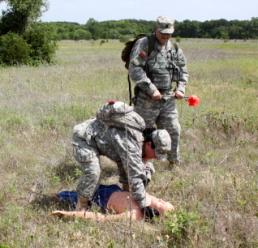 |
| Spc. Michael Ross, Texas State Guard, left, checks a "victim's"vital signs during a mock aviation disaster at Dallas-Fort Worth International Airport, Dallas, June 6, 2014. (Texas State Guard photo by Capt. Esperanza Mesa). |
DALLAS - The Troopers of the Dallas-based 19th Civil Affairs Regiment, Texas State Guard, joined more than a dozen North Texas emergency management agencies in a mass casualty exercise that tested the full-range of the Regiment's mission set.
Operation Thunderbolt, led by the Dallas County Office of Emergency Management and Homeland Security, tested the Regiment's leaders and staffs at every level and provided Troopers unique and challenging training in readiness for this year's hurricane season.
The exercise took place in several communities across North Texas requiring the Regiment to operate simultaneously from numerous locations at the maximum range of its communications capabilities and to move everyday.
“We set out from the beginning to exercise each of our METL tasks in an interagency agency environment on the turf where we’re likely to be employed,” said Col. Robert Hastings, commander of the 19th Regiment. “Every year, our annual training cycle culminates in a hurricane readiness exercise at the beginning of hurricane season.”
The training scenario revolved around a category 4 hurricane bearing down on the gulf coast triggering evacuations of Texas and Louisiana coastal communities and activation of the Dallas mass sheltering plan.
It was further complicated by severe weather in North Texas with multiple tornadoes and severe flooding. In addition to thousands of evacuees, the scenario included mass casualties from an airplane crash and a hazardous chemical accident.
The scenario enabled the Regiment to exercise its emergency response capabilities in communications, mass care, shelter management, evacuee tracking, wide area damage assessment and search and rescue.
The exercise also contained a number leadership reaction scenarios designed to build teamwork and communication.
In one scenario, teams conducted wide area damage assessment in Grapevine, following a simulated tornado strike, discovered civilians and another TXSG team trapped in a “collapsed” warehouse – in reality a Grapevine Fire Department rescue training facility. The teams had to rapidly assess the situation, determine a course of action and evacuate and treat the victims as the building “collapsed” around them.
In another scenario, the Regiment responded to a request for assistance from the Dallas-Fort Worth Airport in Dallas, to help search for missing passengers from a plane crash in a heavily wooded area on the airport.
“This AT tested both our basic and advanced skills in dealing with different real world scenarios and issues," said Sgt. Samantha Shipman, Civil Affairs team leader, Texas State Guard. "It built our teamwork and communications to a new level and gave us an opportunity to find things to improve on that we may have overlooked in previous AT experiences.”
As thousands of "displaced citizens" began flooding into Dallas, the Regiment was redirected to the area of Balch Springs, Kaufman and Terrell to establish shelters and process evacuees. As evacuee “role players” streamed in by bus and carload, Troopers quickly established shelters, emergency tracking network stations and medical treatment stations for special needs patients.
Each of the dozens of role players presented a unique and challenging problem for the shelter teams to deal with. Realism was further driven by injects provided by observer-controllers and civilian emergency management subject matter experts.
“I enjoyed getting the chance to set up and work with the emergency tracking network equipment and though there were some issues, it gave me the chance to practice coming up with a viable solution in real time with people actually waiting,” explained Texas State Guardsman Spc. John Hurst.
The sentiment was echoed by Pvt. Jonathan Miller, a new member of the 19th Regiment, who added that the exercise put all his previous training in context.
“Having just completed my FEMA and Red Cross training, it allowed me to gain real world perspective and partake in multiple disaster scenarios,” said Miller.
The Regiment’s three battalions were augmented by a detachment from the Texas State Guard Medical Brigade, a signals team from the Texas State Guard Military Auxiliary Radio System Detachment and personnel from the Texas State Guard Maritime Regiment.
"When the citizens of the Texas need assistance, exercises like this ensure we'll be ready. It was an opportunity to prove to ourselves and our emergency management partners that we are in fact prepared to respond," said Hastings.